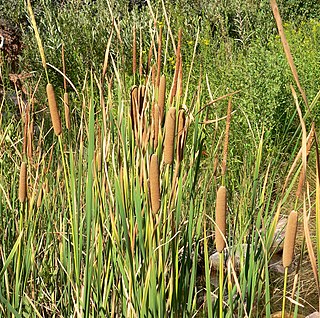
Typha is a genus of about 30 species of monocotyledonous flowering plants in the family Typhaceae. These plants have a variety of common names, in British English as bulrush or reedmace, in American English as reed, cattail, or punks, in Australia as cumbungi or bulrush, in Canada as bulrush or cattail, and in New Zealand as raupo. Other taxa of plants may be known as bulrush, including some sedges in Scirpus and related genera.

Austrians are the people of Austria. The English term Austrians was applied to the population of Habsburg Austria from the 17th or 18th century. Subsequently, during the 19th century, it referred to the citizens of the Empire of Austria (1804–1867), and from 1867 until 1918 to the citizens of Cisleithania. In the closest sense, the term Austria originally referred to the historical March of Austria, corresponding roughly to the Vienna Basin in what is today Lower Austria.

Typha latifolia is a perennial herbaceous plant in the genus Typha. It is found as a native plant species in North and South America, Europe, Eurasia, and Africa. In Canada, broadleaf cattail occurs in all provinces and also in the Yukon and Northwest Territories, and in the United States, it is native to all states except Hawaii. It is an introduced and invasive species, and is considered a noxious weed, in Australia and Hawaii. It has been reported in Indonesia, Malaysia, New Zealand, Papua New Guinea, and the Philippines.

Herdsman Lake, also known as Herdsmans Lake, is a freshwater lake located on the Swan Coastal Plain, 6 kilometres (3.7 mi) north-west of Perth, Western Australia, in the suburb of Herdsman.

Typha angustifolia L. is a perennial herbaceous plant of genus Typha. This cattail is an "obligate wetland" species that is commonly found in the northern hemisphere in brackish locations.

Calamotropha paludella is a species of moth of the family Crambidae. It is found in Europe, Africa, Australia and large parts of Asia.

Typha domingensis, known commonly as southern cattail or cumbungi, is a perennial herbaceous plant of the genus Typha.
The Forrestdale and Thomsons Lakes Ramsar Site comprises two separate nature reserves, totalling 754 ha in area, protecting two shallow fresh to brackish, seasonal lakes in a suburban and agricultural landscape in south-western Western Australia. It lies in the Swan Coastal Plain bioregion and is used mainly for birdwatching and walking. The site is recognised as being of international importance under the Ramsar Convention on Wetlands, under which it was designated Ramsar Site 481 on 7 June 1990.
T. orientalis may refer to:
The Waipu Lagoons is a series of small coastal lagoons near the city of New Plymouth in the Taranaki Region of New Zealand. They consist of three lakelets with a combined surface area of about 2 hectares, located 0.5 kilometres (0.31 mi) from the Tasman Sea, immediately to the east of Bell Block. The lagoons plus surrounding wetlands totalling 7.9 hectares are a local purpose conservation reserve owned by the New Plymouth District Council.

Benger Swamp is a wetland located on the Swan Coastal Plain, in south-west Western Australia.

Typha orientalis, commonly known as bulrush or cumbungi, is a perennial herbaceous plant in the genus Typha. It is native to Australia, New Zealand, Malaysia, Indonesia, Japan, Korea, Mongolia, Myanmar, Philippines, China and the Russian Far East.

Cyperus ustulatus, also known as giant umbrella-sedge or coastal cutty grass is a species of sedge native to New Zealand. C. ustulatus generally grows in coastal or lowland areas near water in the North Island and on the Kermadec Islands.

Bulrushes is the vernacular name for several large wetland grass-like plants in the sedge family (Cyperaceae).
Typha × suwensis is a plant of hybrid origin, endemic to central Japan named after Suwa Province west of Tokyo. It apparently originated as a cross between the two very widespread species T. latifolia and T. orientalis.Typha × suwensis grows in freshwater marshes.

Ōkārito is a small coastal settlement on the West Coast of New Zealand's South Island, 127 kilometres (79 mi) southwest of Hokitika, and 10 kilometres (6.2 mi) from State Highway 6. It is built at the southern end of the Ōkārito Lagoon at the mouth of the Ōkārito River. The settlement of The Forks is located just inland, on the banks of the river.
Yua is a small genus of vines in the family Vitaceae. There are two species in the genus Yua:












